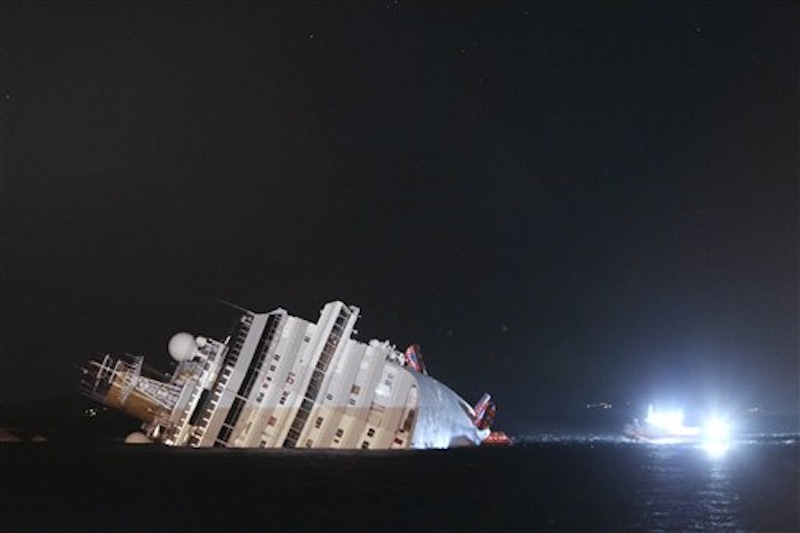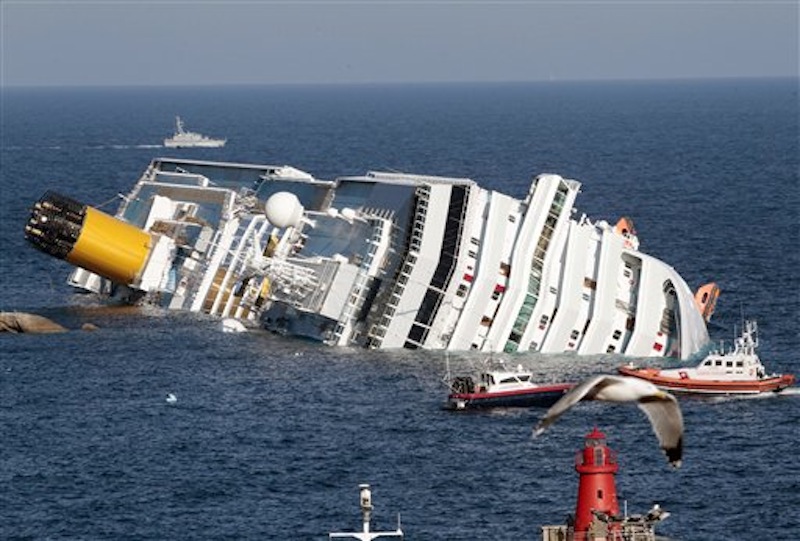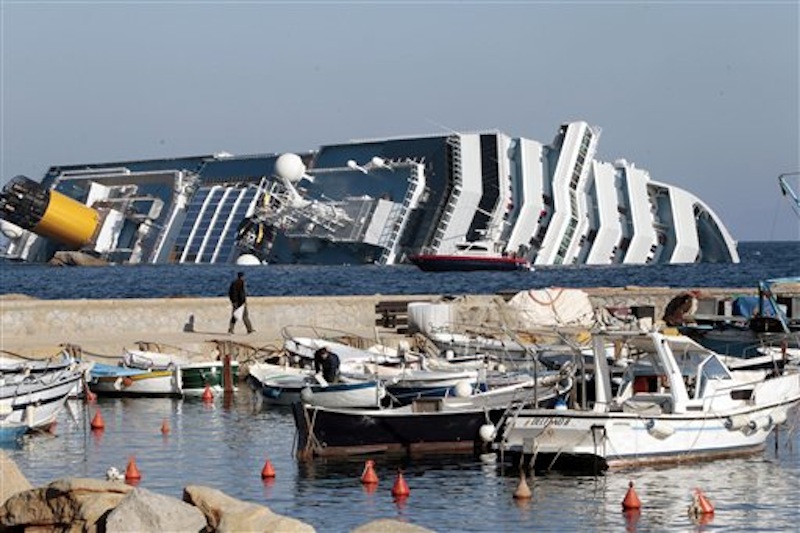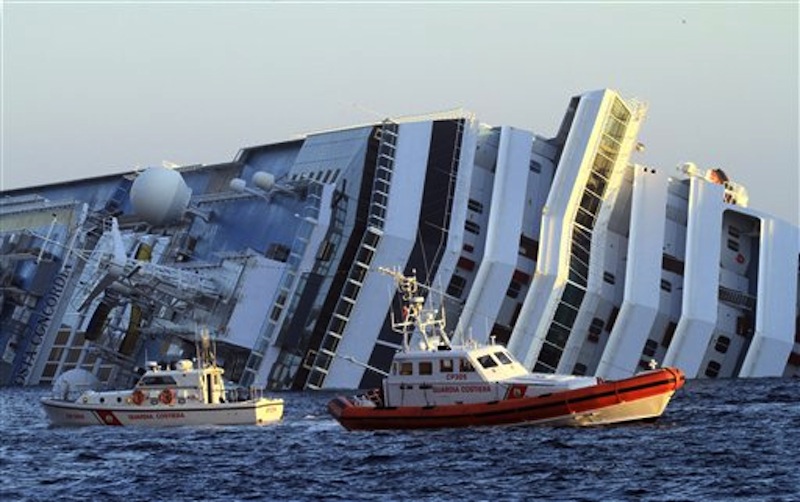PORTO SANTO STEFANO, Italy — The first course had just been served in the Costa Concordia’s dining room when the wine glasses, forks and plates of cuttlefish and mushrooms smashed to the ground. At the magic show in the theater, the trash cans tipped over and the theater curtains turned on their side. Then the hallways turned upside down, and passengers crawled on bruised knees through the dark. Others jumped alone into the cold Mediterranean Sea.
The terrifying, chaotic escape from the luxury liner was straight out of a scene from “Titanic” for many of the 4,000-plus passengers and crew on the cruise ship, which ran aground off the Italian coast late Friday and flipped on its side with a 160-foot (50-meter) gash in its hull. At least three bodies had been recovered and divers searched the underwater belly of the boat for a few dozen more who remained unaccounted for. By late Saturday, the number of missing had dwindled to about 40.
The Friday the 13th grounding of the Concordia was one of the most dramatic cruise ship accidents in recent memory. It immediately raised a host of questions: Why did it hit a reef so close to the Tuscan island of Giglio? Did a power failure cause the crew to lose control? And why did crew members tell passengers they weren’t in danger until the boast was listing perilously to the side?
The delay made lifeboat rescue eventually impossible for some of the passengers, some of whom jumped into the sea while others waited to be plucked to safety by helicopters. Some boats had to be cut down with an axe.
“We had to scream at the controllers to release the boats from the side,” said Mike van Dijk, from Pretoria, South Africa. “It was a scramble, an absolute scramble.”
Van Dijk said the boat he was on — on the upended port side — got stuck along the ship’s wall as it came down.
“It was a hell of a sound, the crunching,” he said.
Costa Crociera SpA, which is owned by the U.S.-based cruise giant Carnival Corp., defended the actions of its crew and said it was cooperating with the investigation. The captain was detained for questioning by prosecutors, investigating him for suspected manslaughter, abandoning ship before all others, and causing a shipwreck, state TV and Sky TV said. Carnival Corp. issued a statement expressing sympathy that didn’t address the allegations of delayed evacuation.
France said two of the victims were Frenchmen; a Peruvian diplomat identified the third victim as Tomas Alberto Costilla Mendoza, 42, a crewman from Peru. Some 30 people were injured, at least two seriously.
The ship began its lurch at the beginning of dinner service in the ship’s two-story dining room, where passengers described a scene of frantic confusion.
Silverware, plates and glasses crashed down on them from the upper floor balcony, children wailed and darkened hallways upended themselves after the ship began its lurch. Panicked passengers slipped on broken glass as the lights went out while crew members insisted nothing serious was wrong.
“Have you seen ‘Titanic’? That’s exactly what it was,” said Valerie Ananias, 31, a schoolteacher from Los Angeles who was traveling with her sister and parents. They all bore dark red bruises on their knees from the desperate crawl they endured along nearly vertical hallways and stairwells, trying to reach rescue boats.
“We were crawling up a hallway, in the dark, with only the light from the life vest strobe flashing,” her mother, Georgia Ananias, 61 said. “We could hear plates and dishes crashing, people slamming against walls.”
She choked up as she remembered the moment when an Argentine couple handed her their 3-year-old daughter, unable to keep their balance as the ship listed to the side.
“He said,’Take my baby,'” Georgia Ananias said, covering her mouth with her hand. “I grabbed the baby. But then I was being pushed down. I didn’t want the baby to fall down the stairs. I gave the baby back. I couldn’t hold her.”
Whispered her daughter Valerie: “I wonder where they are.”
The Ananias family was among the last passengers off the ship, left standing on the upended port side. They were forced to exit from a still-attached lifeboat that became impossible to use once the ship began to tip over; so they climbed a ladder dropped too them off a deck and shimmied down a rope to a waiting rescue vessel.
“We thought we were dying four times,” Valerie said, recounting the most terrifying moments in their escape.
A top Costa executive, Gianni Onorato, said Saturday the Concordia’s captain had the liner on its regular, weekly route when it struck a reef. Italian coast guard officials said the circumstances were still unclear, but that the ship hit an unknown obstacle.
Despite some early reports that the captain was dining with passengers when his ship crashed into the reef, he was on the bridge, Onorato said.
“The ship was doing what it does 52 times a year, going along the route between Civitavecchia and Savona,” a shaken-looking Onorato told reporters on Giglio, a popular vacation isle off Italy’s central west coast.
He said the captain was an 11-year Costa veteran and that the cruise line was cooperating with Italian investigators to find out what went wrong.
Malcolm Latarche, editor of maritime magazine IHS Fairplay Solutions, said a loss of power coupled with a failure of backup systems could have caused the crew to lose control.
“I would say power failure caused by harmonic interference and then it can’t propel straight or navigate and it hit rocks,” Latarche said.
There were no firm indications that anyone was trapped. Rescuers carried out extensive searches of the waters near the ship for hours and “we would have seen bodies,” said Coast Guard Capt. Cosimo Nicastro.
Many passengers complained the crew didn’t give them good directions on how to evacuate and once the emergency became clear, delayed lowering the lifeboats until the ship was listing too heavily for many to be released.
Several other passengers said crew members told passengers for 45 minutes that there was a simple “technical problem” that had caused the lights to go off.
Seasoned cruisers knew better and went to get their life jackets from their cabins and report to their “muster stations,” the emergency stations each passenger is assigned to, they said.
Passengers said they had never participated in an evacuation drill, although one had been scheduled for Saturday. The cruise began on Jan. 7.
Miriam Vitale, a hostess on the cruise liner who disembarked earlier this week in Palermo, told SkyTG24 the ship conducts a drill every 15 days. She said that since passengers on the Concordia embark or disembark every day, some passengers could miss it depending on which day they begin the trip.
Surviving passengers huddled under woolen or aluminum blankets in a middle school on the Italian mainland of Porto Santo Stefano, where passengers were ferried early Saturday from Giglio. Some wore their life preservers, their shoeless feet were covered with aluminum foil.
Christine Hammer, from Bonn, Germany, shivered near the harbor as she waited for a bus to take her somewhere — she didn’t know where. She wore her gray cashmere sweater and a silk scarf with a large pair of hiking boats loaned to her by an islander after she lost her shoes in the scramble. Her passport, credit cards and phone were left in her cabin.
Hammer, 65, said the ship lurched to the side as she ate an appetizer of cuttlefish, sauteed mushrooms and salad on her first night aboard her first-ever cruise, a gift to her and her husband, Gert, from her local church where she volunteers.
“We heard a crash. Glasses and plates fell down and we went out of the dining room and we were told it wasn’t anything dangerous,” she said.
Alan and Laurie Willits from Wingham, Ontario, celebrating their 30th wedding anniversary, said they were watching the magic show in the ship’s main theater when they felt an initial lurch, as if from a severe steering maneuver. That was followed a few seconds later by a “shudder” that tipped trash cans over.
The subsequent listing of the ship made the theater curtains seem like they were standing on their side.
“And then the magician disappeared,” Laurie Willits said.
Florida-based Carnival Corp. issued a brief statement Saturday.
“Our hearts go out to everyone affected by the grounding of the Costa Concordia and especially the loved ones of those who lost their lives. They will remain in our thoughts and prayers in the wake of this tragic event.”
Costa Cruises said about 1,000 Italian passengers were onboard, as well as more than 500 Germans, about 160 French and about 1,000 crew members. The State Department said about 126 U.S. citizens were onboard.
Coast guard Cmdr. Francesco Paolillo said the exact circumstances of the accident were still unclear, but that the first alarm aboard went off about 10:30 p.m., about three hours after the Concordia had begun its voyage from the port of Civitavecchia to Savona, in northwestern Italy. No SOS was sent, he told The Associated Press in a telephone interview.
The vessel “hit an obstacle,” that tore a 50-meter (160 feet) gash in the side of the ship and started taking on water, Paolillo said. It wasn’t clear if the obstacle was a jagged, rocky reef or something else, he said.
The captain, Paolillo said, then tried to steer his ship toward shallow waters, near Giglio’s small port, to make evacuation by lifeboat easier.
Five helicopters from the coast guard, navy and air force took turns airlifting survivors still aboard and ferrying them to safely.
Costa Cruises said the Costa Concordia was sailing on a weeklong cruise across the Mediterranean Sea that began Jan. 7 in Savona with stops at Civitavecchia, Marseille, Barcelona, Palma de Mallorca, Cagliari and Palermo.
The Concordia had a previous accident in Italian waters, ANSA reported. In 2008, when strong winds buffeted Palermo, the cruise ship banged against the Sicilian port’s dock, and suffered damage but no one was injured, ANSA said.
Send questions/comments to the editors.





